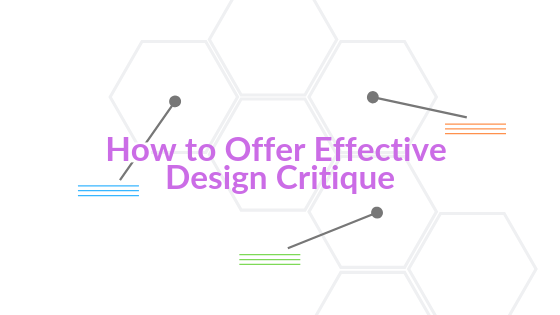What is the importance of giving and receiving feedback?

Critique is the backbone of great designs (when done right). We are constantly providing and receiving feedback; the sales lead providing guidance on successful selling points, a coworker sending a tip for using the new program, or offering design feedback for the redesigned website. Feedback makes us better, but as with all types of critique, there is an effective way to go about it; a way to ensure you are presenting your thoughts or knowledge in a way the recipient will both understand and find useful. And in terms of design, feedback plays a crucial role.
What are the designer’s roles and responsibilities?

First, it is important to explain a designer’s role. It is easy to summarize their position as ‘someone who makes something look pretty.’ But that would mitigate a designer’s expertise and skills and whose objective is to achieve a very real business goal. Making something ‘pretty’ is quite literally just the frosting on the cake. Design thinking in business requires talent and effective design feedback in order to establish a product that will ultimately achieve the goal.
How to work with designers to provide effective feedback
These are the five key feedback design principles for your team to practice during your next critiquing session:
1. Phrase it as Goal-Oriented vs Solution-Oriented

This one is crucial. For your design feedback to be beneficial, it is important to phrase it as achieving a goal, not providing a solution. When you explain the goal, you are subsequently explaining the why behind your dislike. This gives the designer information on why the visual content should be altered and how they can fix it.
Let’s take an example from a website design feedback session:
- Solution-Oriented: “Add the event photos under the header”
- Goal-Oriented: “We want to highlight our events to show our community involvement. Is there a way we can incorporate that?”
By providing the solution, it does not explain your reasoning behind the critique; while taking the goal-oriented position, you explain the business goal and allow the designer to figure out the best way to fix it. You are an expert in business thinking, the designer is an expert in design thinking, if you communicate your goals the designer can create the solution.
2. Provide Visual Examples

Communication in the design process can be difficult because, well, not everyone speaks the same language. Terminology and practices vary from one field to the next, establishing communication barriers for design feedback. The solution? Visual examples.
For example, you may not know what flyout navigation is, but if you provide a link to a website and indicate you like how the submenus expand, your designer will use that design feedback, knowing it is flyout navigation, when designing the website.
Visual examples allow you to specifically show what styles, layouts, and features are appealing so your designer can clearly understand your projected product. It makes communication in design process straightforward and effective.
3. Ask Your Own Design Feedback Questions

There are many well-planned and researched reasonings behind a final design that many are unaware of. It is important to give the designer a chance to explain the rationale behind the design first.
An example of using design feedback questions would be to ask, “What was the thought process behind using this color scheme?” Instead of saying, “I like the neutral colors better.”
There are great ways to frame questions for designers that can push your project further along and there are questions that can hinder the design process. Knowing these differences can ensure your project is well-planned and effective.
4. Take the Perspective of the User when Giving Design Feedback

Design thinking in business relies not on your personal likes or dislikes, but revolves around your audience. What design would captivate and engage your audience? As a critic, you need to take the perspective of the user and offer design feedback that is relevant to the business, not based on your personal preference. In the end, the designer is creating a product for the user to solve the business challenge, not to appease an individual.
5. Give both Positive and Negative Feedback Examples

In a critique session, it is easy to focus on the aspects that you want to be changed. Yet it is just as important to open the conversation to features of the visual content that you like. It allows the designer to understand which parts are working and use those concepts to improve the product. Also, positive feedback vs negative feedback relies on how you position the design feedback. You are critiquing the design, not the person. Try avoiding pronouns, instead focus on the product being reviewed.
For example, phrase the website design feedback as, “The color of the text on the homepage seems dark and could make it difficult for the user to read.” Instead of saying, “Why did you make the text so dark, will the user be able to read it?”
Design feedback is critical for the improvement of a product or design to ensure the end result is addressing and resolving the business problem. To make communication in the design process effective, try altering the design critique to be goal-oriented, present visual examples, ask design feedback questions, think from the user’s perspective, and offer both positive and negative feedback examples.
Learn more about the design process!







